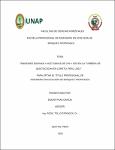| dc.contributor.advisor | Tello Espinoza, Rodil | |
| dc.contributor.author | Peas García, Edgar | |
| dc.date.accessioned | 2022-12-15T18:50:14Z | |
| dc.date.available | 2022-12-15T18:50:14Z | |
| dc.date.issued | 2022 | |
| dc.identifier.uri | https://hdl.handle.net/20.500.12737/8619 | |
| dc.description.abstract | The study was conducted in the peatlands of the Quistococha – Iquitos Zoo. The objective was to estimate the daily cycle of CH4 and N2O gas flows in relation to the environmental variables of the Quistococha peatland in Loreto – Peru; where, the closed chamber methodology (typically <1m2) was used, which consists of measuring the flow of trace gases of CH4 and N2O (Hutchinson and Livingston, 1993). The daily cycles of the CH4 flow in the Peatland of Quistococha, during the first and second campaign presented an average of 2407,9 and 2154,5 (?g-C/m?2/h?1), respectively. Likewise, N2O presented a daily average of 37,3 and 5,4 (?g-N/m?2/h?1), respectively. It was observed that there are slight differences in the flows of CH4 and N2O gases between day and night, being greater during the day the average flow of CH4, first campaign (2576,33 and 2239,49 ?g-C/m?2/h?1, respectively) and second campaign (2446,36 and 1862,59 ?g-C/m?2/h?1, respectively) constantly, and inconsistently in relation to the average flow of N2O, first campaign (40,69 and 33,85 ?g-N/m?2/h?1, respectively) and second campaign (4,87 and 5,36 ?g-N/m?2/h?1, respectively), but no significant differences were found with respect to the different shifts (day and night), nor between the different times of the day, according to Wilcoxon and kruskal wallis tests, respectively. The environmental variables of soil temperature, photosynthetically active radiation and water table do not significantly influence the daily flow of CH4 and N2O in the Quistococha peatland, according to the spearman test, since they presented low and null correlations. | en_US |
| dc.description.abstract | El estudio se realizó en las turberas del parque zoológico de Quistococha, Iquitos. El objetivo fue estimar el ciclo diario de los flujos de gases de CH4 y N2O en relación a las variables ambientales de la turbera de Quistococha en Loreto – Perú; donde, se utilizó la metodología de cámara cerrada (típicamente <1m2), que consiste en medir el flujo de gases trazas de CH4 y N2O (Hutchinson y Livingston, 1993). Los ciclos diarios del flujo de CH4 en la turbera de Quistococha, durante la primera y segunda campaña presentó un promedio de 2407,9 y 2154,5 (?g-C/m?2/h?1), respectivamente. Así mismo, durante la primera y segunda campaña el N2O presentó un promedio diario de 37,3 y 5,4 (?g-N/m?2/h?1), respectivamente. Se observó que existe ligeramente diferencias en los flujos de los gases de CH4 y N2O entre el día y la noche, siendo mayor durante el día el flujo promedio de CH4, primera campaña (2576,33 y 2239,49 ?g-C/m?2/h?1, respectivamente) y segunda campaña (2446,36 y 1862,59 ?g-C/m?2/h?1, respectivamente) de manera constante, e inconstante en relación al flujo promedio de N2O, primera campaña (40,69 y 33,85 ?g-N/m?2/h?1, respectivamente) y segunda campaña (4,87 y 5,36 ?g-N/m?2/h?1, respectivamente), pero no se encontraron diferencias significativas con respecto a los diferentes turnos (día y noche), ni entre los diferentes horarios del día, según test de Wilcoxon y kruskal wallis, respectivamente. Las variables ambientales de temperatura de suelo, radiación fotosintéticamente activa y el nivel freático, no influyen de manera significativa en el flujo diario de CH4 y N2O en la turbera de Quistococha, según el test de spearman, ya que presentaron correlaciones bajas. | es_PE |
| dc.format | application/pdf | es_PE |
| dc.language.iso | spa | es_PE |
| dc.publisher | Universidad Nacional de la Amazonía Peruana | es_PE |
| dc.rights | info:eu-repo/semantics/openAccess | * |
| dc.rights.uri | https://creativecommons.org/licenses/by/4.0/ | * |
| dc.subject | Emisiones de gas | es_PE |
| dc.subject | Emisiones de metano | es_PE |
| dc.subject | Óxido nitroso | es_PE |
| dc.subject | Turberas | es_PE |
| dc.title | Emisiones diurnas y nocturnas de CH4 y N2O en la turbera de Quistococha en Loreto, Perú, 2021 | es_PE |
| dc.type | info:eu-repo/semantics/bachelorThesis | es_PE |
| thesis.degree.discipline | Ingeniería en Ecología de Bosques Tropicales | es_PE |
| thesis.degree.grantor | Universidad Nacional de la Amazonía Peruana. Facultad de Ciencias Forestales | es_PE |
| thesis.degree.name | Ingeniero(a) en Ecología de Bosques Tropicales | es_PE |
| dc.subject.ocde | https://purl.org/pe-repo/ocde/ford#4.01.02 | es_PE |
| renati.author.dni | 74213459 | |
| renati.advisor.orcid | https://orcid.org/0000-0001-9413-6037 | |
| renati.advisor.dni | 06444169 | |
| renati.type | https://purl.org/pe-repo/renati/type#tesis | es_PE |
| renati.discipline | 521226 | es_PE |
| renati.level | https://purl.org/pe-repo/renati/level#tituloProfesional | es_PE |
| renati.juror | Rodriguez Gomez, Jorge Luis | |
| renati.juror | Fachin Malaverry, Lizardo Manuel | |
| renati.juror | Vasquez Bardales, Joel | |
| dc.publisher.country | PE | es_PE |


